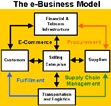The E-Space

By Raymond C. Smith,
CEO, IntraMark, Inc.
What E-Business Really Means
When Oil & Gas Online first asked me to write a column on "e-commerce in the oil and gas industry," it seemed like an excellent opportunity, for two reasons. First, it could help readers get a better look at some of the more exciting developments that will change the way we all do business in the future. Second, it could help people understand how to make the Internet work better for them. We all need a bit of clarity about where things are headed in the online space.
To provide clarity, however, let's begin by clearing up a bit of terminology that people often get confused—that is the difference between "e-commerce" and "e-business." I hear many people using these terms interchangeably but they are quite different. In fact, e-commerce is really just a subset of e-business as the following diagram shows:

When people first saw the promise of the Internet in the mid-1990s, they thought of it primarily as a sales-and-marketing tool that could facilitate commerce. Over the past few years, however, it has become increasingly clear that all facets of business—not just sales—must gravitate toward a more online, interactive, Web-based model. So whereas people two years ago were primarily interested in putting their sales catalog online, today's innovative companies are struggling to put their entire business online. That's what e-business is all about.
The e-business model is not just about having a cool web site on the Internet. In fact, it uses the company intranet, extranets, and the Internet to facilitate every part of a company's operations, including the commerce, procurement, fulfillment, and customer service functions. It facilitates popular business techniques such as teamwork and collaboration. It also encompasses such advanced business concepts as knowledge management, supply chain management, customer relationship management, and one-to-one marketing.
If you think, for any reason, that this sort of model doesn't apply to our industry, think again. In fact, the oil industry was one of the first commercial groups to get involved in e-business, even though we didn't call it that. The idea of e-business really supports the whole concept of selling services—as well as commodities and high-value products—which is really what the oil industry is all about. In reality, we were all e-business pioneers long before the Web arrived.
To give a commodity-based example: the spot market that arose in the late 1980s is still a fairly pure model of e-business. When companies began trading for oil, there were very quickly many information tools supporting it. Traders and buyers had immediate access to information about commodities that were available for sale. If you had something to sell, people could come in, make offers against it, and buy it.
Thus, for well over a decade, our industry has grown used to the idea that you can sell your output through a marketplace that is very much electronic. And of course, with the arrival of the Internet, it has become even more so. Many aspects of business that were once conducted using telephones, teletypes, and fax are now moving onto the Web.
But let's not forget the services example, which is pervasive in our industry. One interesting aspect of the oil business is the way that the collaborative services model has developed, with lots of companies partnering on cross-functional or cross-business projects that involve technology transfers.
If you have a site in the deepwater Gulf of Mexico, for instance, all of the partnering companies—whether oil companies, supply companies, or seismic companies—are all using a form of e-business to interface, exchange knowledge, and make sure that the development of that asset proceeds in the most efficient and effective manner. All the tools being used on these projects are really e-business tools—including e-mail, shared knowledge bases, wide area-based project management tools, and videoconferencing.
So if we've been doing e-business for all along, why are people making such a big deal about it now? And even bother explaining what it is?
What's shockingly different about today's picture is the Internet itself. The e-business that we conduct today is increasingly being supported by cutting-edge Internet technologies.
Why? Because the Internet—and its corollary extranets and intranets—are based on a completely open non-proprietary model of information exchange. The Internet finally removes all the barriers between incompatible computer operating systems, proprietary networks, and communications systems, and gives us all a single playing field on which we can all collaborate—or compete—without obstruction. Furthermore, it provides a communications network that is global and that can be easily accessed by anyone, anywhere in the world.
As the Internet becomes more pervasive in our lives, we are all searching for ways to make sense of it, as well as to use it for competitive advantage. That is what I hope to help you understand in the coming months, in future issues of this column.
About the Author
Raymond C. Smith, CEO of IntraMark, was formerly a CIO and CFO with BP-Amoco, working for 17 years in the UK, Europe, Africa, and the Americas. In his current role at IntraMark, he helps clients hone their e-business strategy and applications through a series of workshops and development activities.
(back to top)
